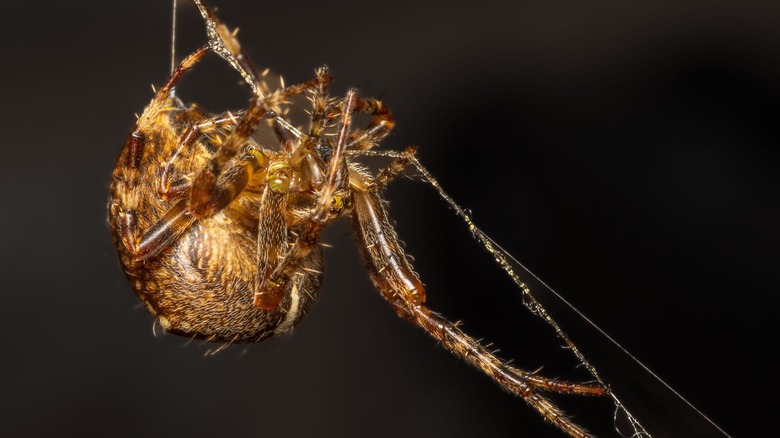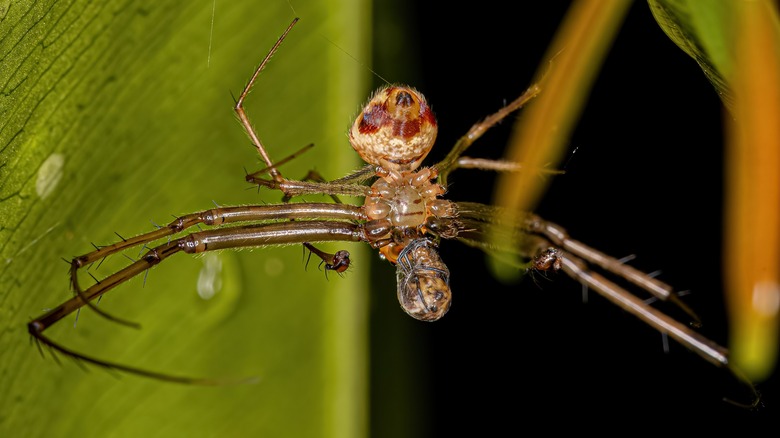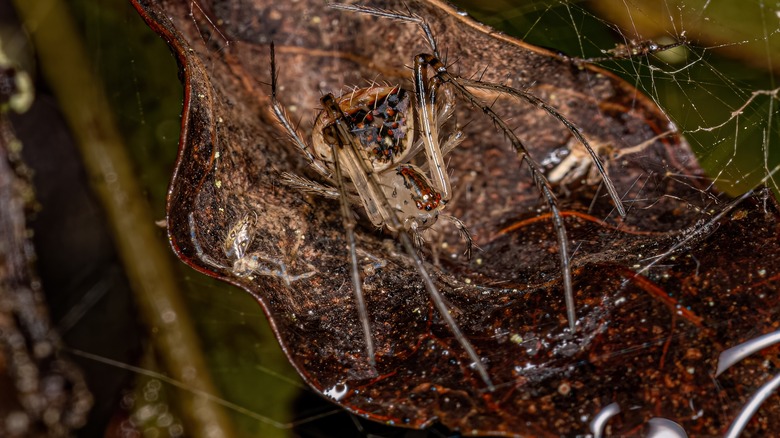The Pirate Spider Uses These Sneaky Tricks To Trap Other Spiders
Spiders have a reputation for epitomizing the term "creepy crawly," but they also do a lot of good, serving as one of the best forms of natural pest control there is and helping to maintain ecological balance. But there's just something truly insidious about pirate spiders, and not just because they're cannibals. These particular arachnids have multiple tricks for trapping their own kind, most of which involve deceiving other spiders into thinking they're either going to eat or mate before they're devoured.
Pirate spiders are members of the family Mimetidae, which comprises between 150 and 200 species divided into between 8 and 13 genera (work is ongoing to fully taxonomize the Mimetidae family). Members of this group are known as Mimetids, are usually yellow and brown, and don't actually make their own webs. They're also ruthless in their pursuit of other spiders on which to feast and are known for tapping existing webs to lure the owners out, essentially tricking them into thinking they've caught prey. These pirate spider species are also so dastardly that they'll mimic the rhythms of mating dances typically performed by other spiders, luring potential mates out into the open and striking.
You might think the species couldn't get much more devious than that, but scientists working in Costa Rica have now discovered yet another nefarious trick used by a species of pirate spider which has been dubbed the "walk the plank" technique.
Pirate spiders might be the sneakiest of all arachnids
Mimetid spiders live in forests around the world, though Central and tropical South America have the most species diversity. But you can find pirate spiders in many places, including in North Dakota, where they are one of the common spiders within the state. Not that you'd necessarily want to find them. These Araneophagic arachnids (meaning they eat spiders) aren't the most inviting little creatures. Everything about them seems intimidating — most notably the rows of hairs on their front legs, which are actually raptorial spines used to ensnare prey. Once a helpless spider is caught by a Mimetid, they'll become encased in a basket-like structure formed by the pirate spider arranging its legs to trap the prey.
But that's not the most upsetting thing about pirate spiders. Easily the sneakiest behavior exhibited by these devious predators is what's known as aggressive mimicry. This involves species of Mimetid spiders invading the webs of other spiders and simulating the movements of either prey or courtship dances to lure the owner of the web out. Once that other spider appears, the pirate spider ambushes them, trapping and feeding on them. So basically, these smaller spiders think they're either going to eat or mate, only to become ensnared in some nightmare hair basket and devoured by a larger spider.
That said, pirate spiders were once thought to only eat other spiders, but research has shown that they are actually "kleptoparasitic," which means they will invade spiders' webs and feed on the prey already caught there. They'll also prey on other arthropods and exhibit active foraging behavior in their search for alternate food sources. On the whole, though, pirate spiders are known for feeding on their own kind (as is another spider species, which is turning to cannibalism). But pretending to be prey or an aroused male isn't the only trick Mimetids use.
Some pirate spiders make their prey walk the plank
In a study published in the journal Animal Behavior, arachnologists studied the web and capturing behavior of a pirate spider species called Gelanor siquirres. The spider, which was observed in the lowland rainforests of Heredia province, Costa Rica, used a whole new technique that adds yet another unsettling trick to the species' arsenal of predator tactics.
The study, entitled "A novel prey capture strategy in pirate spiders," details how researchers viewed pirate spiders intercepting the web strands of orb weaver spiders, before essentially making these smaller spiders "walk the plank" to their doom. As the authors noted, pirate spiders might not spin webs, but some species, including Gelanor siquirres, do spin lines of dry silk which they drop from their hiding places, or "retreats." These floating lines of silk would intercept the lines spun by orb weaver spiders. Smaller spiders typically spin strands of silk which attach to other surfaces, then scuttle along the line, secure it at the other end, and use this as the basis for their web. But when Gelanor siquirres lines intercept the orb weavers' lines, that allows the pirate spiders to take advantage of their prey's web-building technique.
Essentially, pirate spiders are dropping lines of silk from their leaf hideaways, hoping a smaller spider spins a floating line which will then attach to their own. They descend down that line to intercept the orb weaver as it "walks the plank" to its demise, in what is surely one of the most impressive and disturbing spider adaptations. This discovery represented the first time such a foraging strategy had been seen in pirate spiders. As one of the study's authors, Gustavo Hormiga, a biologist at George Washington University in Washington, D.C., told Science News, intercepting other spiders as they build webs is "actually pretty sophisticated. I don't know of anything like that in any [other] spider group."


